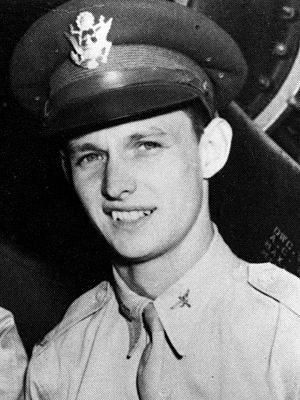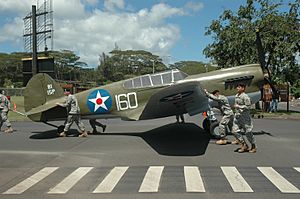George Welch (pilot) facts for kids
Quick facts for kids
George Welch
|
|
|---|---|
 |
|
| Birth name | George Lewis Schwartz, Jr. |
| Born | May 10, 1918 Wawaset Park, Wilmington, Delaware, US |
| Died | October 12, 1954 (aged 36) Palmdale, California, US |
| Buried | |
| Allegiance | United States |
| Service/ |
United States Army Air Corps United States Army Air Forces |
| Years of service | 1939–1944 |
| Rank | Major |
| Unit | 47th Fighter Squadron 36th Fighter Squadron 80th Fighter Squadron |
| Battles/wars | World War II |
| Awards | Distinguished Service Cross Silver Star Distinguished Flying Cross (3) Air Medal (2) |
| Other work | Test pilot |
George Schwartz Welch (born May 10, 1918 – died October 12, 1954) was a brave World War II pilot. He was known as a "flying ace" because he shot down many enemy planes. He was also a special kind of pilot called an "experimental aircraft pilot" or "test pilot" after the war.
Welch is famous for being one of the few United States Army Air Corps pilots who managed to get into the air during the surprise attack on Pearl Harbor. He fought against the Japanese forces that day. After the war, he became a test pilot for a company called North American Aviation. He helped test new and exciting airplanes.
Contents
George Welch's Early Life and Training
George Schwartz Welch was born as George Lewis Schwartz, Jr. His parents changed his name to avoid bad feelings against German names after World War I. His father was a scientist who worked for Dupont.
George had a younger brother named Dehn. George went to St. Andrew's School (Delaware). He studied engineering at Purdue University for three years. Then, in 1939, he joined the United States Army Air Corps. He trained at several airfields in Texas and California, learning to fly military planes.
Heroic Actions in World War II
After finishing his flight training in January 1941, Welch became a Second Lieutenant. He was sent to Wheeler Army Airfield in Hawaii in February 1941.
Defending Pearl Harbor
On December 7, 1941, early in the morning, Japanese planes attacked Pearl Harbor. Lieutenant Welch and another pilot, Lieutenant Kenneth M. Taylor, were returning from a party. They were still in their fancy uniforms when the attack began!
Welch quickly called Haleiwa Fighter Strip to get two Curtiss P-40 Warhawk planes ready. He and Taylor drove very fast to the airfield. When they got there, the ground crew told them to spread out their planes for safety. Welch said, "To hell with that," and they quickly got into their fighters.
They took off with only light machine gun ammunition. Welch shot down two Japanese dive bombers over Marine Corps Air Station Ewa. One of the Japanese planes was damaged, and the other was finished off by Ken Taylor.
Welch landed at Wheeler Field to get more powerful ammunition. On his second flight, he shot down another dive bomber and a Japanese fighter plane.
Both Welch and Taylor were suggested for the highest military award, the Medal of Honor. Instead, they received the Distinguished Service Cross. This is the second-highest medal for bravery in the U.S. Army.
Fighting in New Guinea
After Pearl Harbor, Welch went back to the United States to give speeches and help sell "war bonds" to support the war effort. Later, he was sent to New Guinea to join the 36th Fighter Squadron.
He wasn't happy flying the Bell P-39 Airacobra plane because it wasn't very fast or powerful. On December 7, 1942, exactly one year after Pearl Harbor, Welch shot down three more Japanese planes. He kept asking to be moved to a squadron that flew the faster Lockheed P-38 Lightning planes.
Finally, he got his wish and joined the 80th Fighter Squadron. Flying a P-38H, Welch shot down nine more Japanese planes between June and September 1943. He completed three tours of duty, flying 348 combat missions. He had 16 confirmed victories against enemy aircraft. His time fighting ended when he got malaria, a serious illness.
Breaking the Sound Barrier
In 1944, a company called North American Aviation asked Welch to become a test pilot. With a recommendation from General Arnold, Welch left the Army Air Forces and took the job.
He helped test new planes like the North American FJ-1 Fury and the XP-86. The XP-86 was a very important plane because it was the first U.S. jet with swept-back wings. This design helped planes fly much faster. Welch was chosen as the main test pilot for this exciting project.
First Flight of the XP-86
The first XP-86 prototype was moved to a test facility (now Edwards AFB) in September 1947. Welch made the first flight of the XP-86 on October 1, 1947.
During the landing, the plane's nose landing gear wouldn't come down properly. Welch tried for 40 minutes to fix it. When he was low on fuel, he decided to land the plane on a dry lake bed without the nose gear fully extended. Luckily, as the plane slowed down, the nose gear popped into place, and the plane was not damaged.
The Race for Mach 1
The Secretary of the Air Force told North American that they should not break the sound barrier before another plane, the Bell X-1, did. Welch's only complaint about the XP-86 was that its engine wasn't powerful enough.
Some people believe that Welch might have broken the sound barrier in the XP-86 two weeks before Chuck Yeager did in the X-1. Welch himself never said this. However, some records from radar tracking on November 13, 1947, suggest that Welch's flights that day might have been supersonic. Also, a "sonic boom" (the sound made when something breaks the sound barrier) was heard over the desert that day, shortly before the X-1 officially broke the record.
Official flight records show that Welch reached about 0.93 Mach (just under the speed of sound) in 1947. On October 14, 1947, Captain Charles Yeager officially became the first person to fly faster than the speed of sound in the Bell X-1.
Later Career and Tragic Death
Welch continued to work as a chief test pilot and instructor for North American Aviation during the Korean War. It is said that he shot down several enemy MiG-15 jets while "supervising" his students. These kills were against direct orders for him not to fight, so the credit for them was given to his students.
After the Korean War, Welch went back to testing planes. He became the first person to break the sound barrier in level flight with the North American F-100 Super Sabre on May 25, 1953.
Sadly, on October 12, 1954, Welch's F-100A Super Sabre broke apart during a high-speed maneuver. The plane crashed in the Mojave desert. Welch was found severely injured in his ejection seat. He was taken by helicopter to a hospital but was pronounced dead when he arrived. He is buried in Arlington National Cemetery.
In the 1970 movie Tora! Tora! Tora!, which was about the attack on Pearl Harbor, George Welch was played by actor Rick Cooper.
Awards and Decorations
George Welch received many awards for his bravery and service:
 USAAF Pilot Badge
USAAF Pilot Badge Distinguished Service Cross
Distinguished Service Cross Silver Star
Silver Star- Distinguished Flying Cross with two bronze oak leaf clusters
- Air Medal with one oak leaf cluster
- Air Force Presidential Unit Citation with two bronze oak leaf clusters
- American Defense Service Medal with one service star
 American Campaign Medal
American Campaign Medal- Asiatic-Pacific Campaign Medal with six campaign stars
 World War II Victory Medal
World War II Victory Medal



